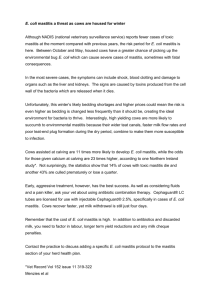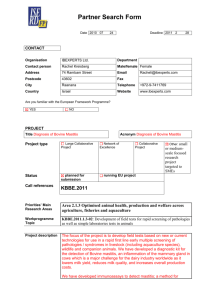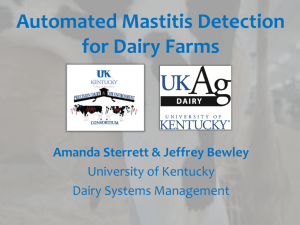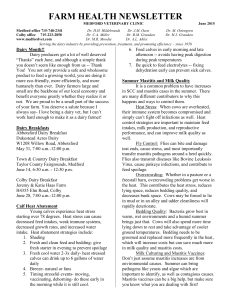Mastitis causing organisms below were scanned from “Laboratory Handbook On... 1999. National Mastitis Council, Inc. Madison, WI
advertisement
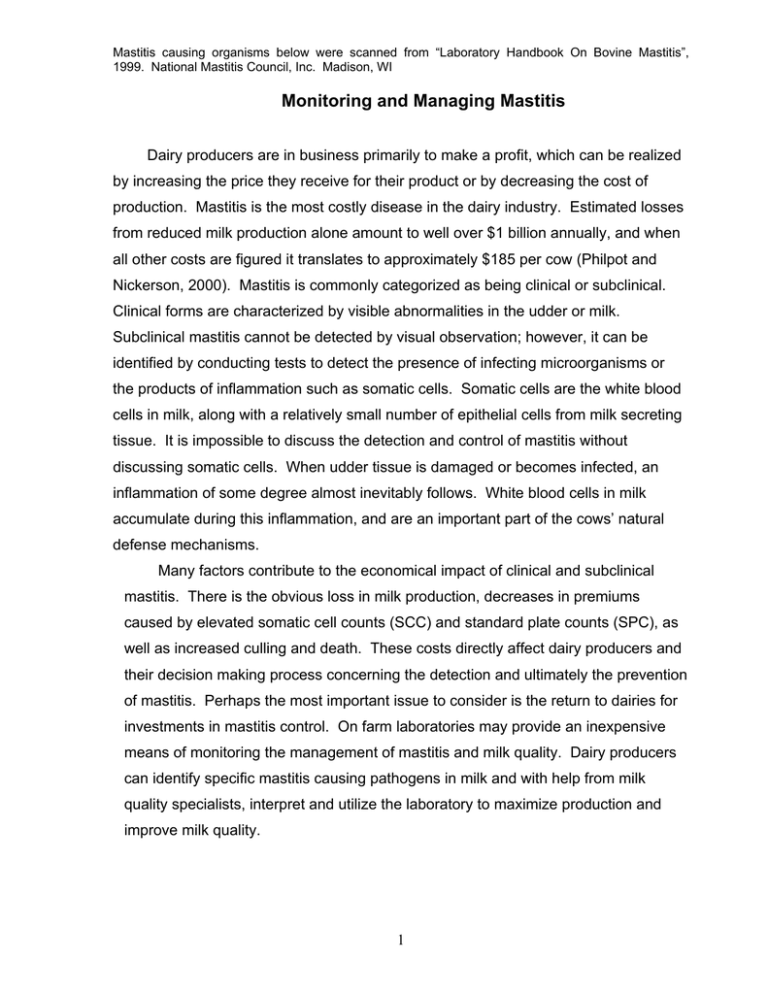
Mastitis causing organisms below were scanned from “Laboratory Handbook On Bovine Mastitis”, 1999. National Mastitis Council, Inc. Madison, WI Monitoring and Managing Mastitis Dairy producers are in business primarily to make a profit, which can be realized by increasing the price they receive for their product or by decreasing the cost of production. Mastitis is the most costly disease in the dairy industry. Estimated losses from reduced milk production alone amount to well over $1 billion annually, and when all other costs are figured it translates to approximately $185 per cow (Philpot and Nickerson, 2000). Mastitis is commonly categorized as being clinical or subclinical. Clinical forms are characterized by visible abnormalities in the udder or milk. Subclinical mastitis cannot be detected by visual observation; however, it can be identified by conducting tests to detect the presence of infecting microorganisms or the products of inflammation such as somatic cells. Somatic cells are the white blood cells in milk, along with a relatively small number of epithelial cells from milk secreting tissue. It is impossible to discuss the detection and control of mastitis without discussing somatic cells. When udder tissue is damaged or becomes infected, an inflammation of some degree almost inevitably follows. White blood cells in milk accumulate during this inflammation, and are an important part of the cows’ natural defense mechanisms. Many factors contribute to the economical impact of clinical and subclinical mastitis. There is the obvious loss in milk production, decreases in premiums caused by elevated somatic cell counts (SCC) and standard plate counts (SPC), as well as increased culling and death. These costs directly affect dairy producers and their decision making process concerning the detection and ultimately the prevention of mastitis. Perhaps the most important issue to consider is the return to dairies for investments in mastitis control. On farm laboratories may provide an inexpensive means of monitoring the management of mastitis and milk quality. Dairy producers can identify specific mastitis causing pathogens in milk and with help from milk quality specialists, interpret and utilize the laboratory to maximize production and improve milk quality. 1 Mastitis causing organisms below were scanned from “Laboratory Handbook On Bovine Mastitis”, 1999. National Mastitis Council, Inc. Madison, WI On-Farm Laboratory Primary uses: 1. Daily milk quality monitoring. 2. Identifying what problems exist. 3. Recommended sampling: replacements (selective), fresh cows, and clinical cows. Supplies and costs, to set up an on-farm laboratory: Incubator Disposable loops Blood auger plates Sample vials Light Marker Paper towels $299.00 $0.06 (a piece) $1.28 (a piece) $0.09 (a piece) $10.99 $0.89 $0.99 By identifying the mastitic organism(s) your cows are infected with, you can improve prevention and treatment. On farm laboratories, used properly, allow dairy producers to detect subclinical mastitis in cows. In addition, laboratories can expose other problems such as cows not being sanitized properly during milking, cows being milked wet, poor maternity housing/bedding management, or heifers calving with mastitis. It is relatively easy to differentiate between contagious and environmental mastitis causing organisms, however, it is difficult to differentiate within coagulase negative Staph species and within environmental streps. In addition, establishing an effective on-farm laboratory has some challenges, 1) sample contamination during collection; 2) training employees to accurately identify organisms; 3) effectively communicating the information between employees and management; and 4) effectively utilizing the information to improve mastitis control and overall milk quality. An on-farm lab may not be applicable to every dairy; however, routine sampling of fresh cows and clinical cows in addition to bulk tank milk samples is warranted. Finally, if an effective on-farm laboratory is set up and used, it is important to validate it regularly with a proven milk quality laboratory. 2 Mastitis causing organisms below were scanned from “Laboratory Handbook On Bovine Mastitis”, 1999. National Mastitis Council, Inc. Madison, WI 3M Petri film currently used to detect total coliform. 3 3M Petri film currently used to detect Staphylococcus aureus.

